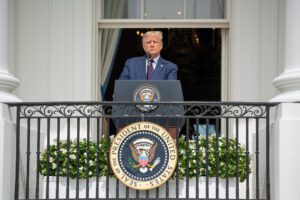Event Video: Phase 2: The Art of the Deal with China
Even as the Trump Administration imposes tariff hikes on Chinese imports, the prospect of negotiating a new trade agreement, a so-called Phase Two deal, remains on the table. But how realistic is this possibility? What key elements would the United States need to include to make such a deal meaningful? What concessions would China demand in return? And what lessons can we draw from the Phase One negotiations and its implementation to guide this effort?
On Tuesday, April 22, WITA and the Asia Society Policy Institute hosted a discussion panel addressing all these questions.
Featured Speakers:
Christopher Adams, Senior Advisor, Covington & Burling LLP
Craig Allen, Senior Counselor, The Cohen Group; former President, US-China Business Council
Jeff Gerrish, Partner, Schagrin Associates; former Deputy U.S. Trade Representative for Asia, Europe, the Middle East, and Industrial Competitiveness, Office of the U.S. Trade Representative
Lingling Wei, Reporter, The Wall Street Journal
Moderator: Wendy Cutler, Vice President, Asia Society Policy Institute (ASPI)
04/22/2025 | WITA
How to Strike Trade Deals in Record Time
Wendy Cutler, the author of this piece, moderated WITA’s joint event with the Asia Society Policy Institute on April 22, 2025. Learn more here.
U.S. trading partners must have breathed a sigh of relief last week when President Donald Trump announced a 90-day pause on the imposition of tariff rates above 10 percent. However, along with Trump’s economic team, they are quickly realizing that the three-month reprieve, while welcome, is an incredibly short time to hammer out trade deals. Typically, U.S. officials spend at least six months—twice the length of time of the current pause—just to develop their negotiating positions in consultation with Congress and stakeholders. Actual negotiations usually span several years. But as we are learning, these are not normal times.
Countries around the world are scrambling to pull together the best teams and develop strategies, tactics, and substantive offers for a trade negotiation with the United States. The very first thing these countries need to consider is whether they want to push to be at the front of the negotiating queue, a potentially attractive option if they conclude that going early may lead to softer deals. Some may decide that they are better off hanging back and watching how others fare first. This would allow them the opportunity to at least gain a better sense of which negotiating topics (or sweeteners) are of the most importance to the White House and potentially to learn from others’ missteps in this new speed-negotiating world.
Thus far, the Trump administration has referenced a long list of requests of foreign counterparts, including tariff cuts, reductions in trade deficits, increased purchases of U.S. goods, cooperation on countering the China challenge, and much else. Trading partners rightly are now looking for clarity on which of these issues are must-haves, allowing them to focus their efforts on what matters most to the White House during this short window.
Countries are also unclear on whether these negotiations can lead to tariffs below the 10 percent universal rate now in place or whether that rate represents a floor. In addressing this question, Trump indicated last week that there may be some narrow flexibility—but not much. With the recent announcements of special exclusions for phones and other electronic products from the tariff hikes, countries must be more confident now asking for further product exclusions to help their domestic companies weather the tariff storm.
In my recent conversations, foreign trade negotiators have expressed exasperation about making major announcements of U.S. investments or purchases without receiving any credit for these actions in the tariff rates assigned to their countries. To avoid this trap, many are likely to now ascribe to a traditional trade negotiating mantra: Nothing is agreed until everything is agreed.
04/15/2025 | Wendy Cutler | Foreign Policy
US Manufacturing Jobs and Gen Z Workers—Can Common Ground Be Found?
The “make in America” agenda has been leading many of the biggest administrative changes and tariff upfolding right now. As a result, manufacturing jobs are expected to return to the country in the long run, but will Gen Z be willing to take up the work when the time comes? The manufacturing industry is expected to add 3.8 million new jobs to the market by 2033, which will mean a whole variety of trade jobs for Gen Z workers who will soon make up the biggest slice of the workforce.
Boomers will be left to the retirement jobs and positions that best utilize their knowledge and strength while millennials will continue to dominate the corporate world for years to come. As manufacturing jobs begin to present the only opportunities for young workers, some tough choices will have to be made on what is to come.
MANUFACTURING JOBS AND GEN Z: A MATCH MADE IN THE POST-TARIFF ERA
In the last few years, many Gen Zers are shifting away from college education and skipping straight to trade schools and labor work. There are many reasons for the shift. Some Gen Z workers no longer see the value of a college degree as educated workers are often stuck doing jobs that have nothing to do with their intended careers.
College degrees have also been seen as insufficient in actually preparing workers for white collar jobs. These degrees may bless students with textbook-based knowledge, but they haven’t entirely kept up with the times and expanded to provide Gen Zers with the workplace skills they need in a post-pandemic world.
GEN Z WORKERS ARE OPEN TO EXPLORING BLUE-COLLAR JOBS
In the last few years, Gen Z workers have developed a fascination for blue-collar jobs. These jobs have improved the pay and working conditions offered to workers, and in recent years, have also grown to be significantly more flexible. Workers are joining family businesses and starting their own, after embracing the DIY-er spirit and taking matters into their own hands.
Blue-collar work has become popular on social media platforms like TikTok, further inspiring teens to take an interest in building a career in fields like metal work and carpentry. Putting on a neon safety vest and pink rubber boots is now more of a fashion statement than the uncomfortable heels required in the corporate setup, so the shift in approach has been a big one.
Avoiding student loans by skipping college is just another one of the many advantages of switching to blue-collar work. The Gen Z workforce face many issues, but one thing they understand best is working on their own terms and expressing themselves creatively. Many blue-collar jobs offer just that.
04/21/2025 | Ava Martinez | The HR Digest
How American Business Can Prosper In The New Geopolitical Era
As President Calvin Coolidge said, in so many words, “The business of America is business.” One hundred years later, his words still ring true, as American businesses have a profound impact on American lives and livelihoods. American businesses employ roughly 83 percent of the US labor force, equivalent to about 136 million jobs—nearly half of which belong to small businesses with fewer than 500 employees. And of course, all Americans depend on commerce to supply the goods and services needed for daily life.
For roughly the past 30 years, geopolitics has taken a back seat relative to macroeconomic, strategic, and technological concerns for businesses. But today, a new hurdle looms: 900 executives tell McKinsey that they see geopolitics as the greatest risk to economic growth.
They’re not wrong. Business leaders understand that a reconfiguration of global trade is underway. Consider that the China tariffs imposed by President Trump were expanded by President Biden, and most of China’s retaliatory tariffs remain in place. And in April 2025, new base and reciprocal tariffs are scheduled to take effect on US trading partners. The uncertainty about the tariffs and possible retaliations or negotiations have created one of the greatest levels of peacetime uncertainty for US businesses. The facts speak for themselves: American business is in a new era of geopolitics, with significant implications.
The United States has long been the lynchpin of the global economy. Its economic preeminence in the years and decades to come will rest on a philosophical and opportunistic alignment between government and business, working in parallel to navigate shifts in global politics, economics, trade, and security.
Ten drivers of geopolitical change
As the United States seeks to update the rules of trade, economics, and security, and other nations react, we inevitably face profound uncertainty. Yet, even in the face of this change, business leaders need to seek understanding and act. As US policymakers reconsider and adjust across ten major drivers of geopolitical change, US businesses can bound the uncertainty by understanding the principles guiding potential US policies. Some shifts are intended to encourage a rewiring of the industrial base for national security or reindustrialization, while others are meant to build leverage in negotiations. Understanding the distinction can ensure long-term realignment of corporate investments and operations with government policies, instead of mere tactical, near-term moves to mitigate risks.
04/23/2025 | Matt Watters, Shubham Singhal & Zoe Fox | McKinsey & Company
WITA – We put the community in trade community.
Information about upcoming WITA and trade community events





